The United States Navy, United States Coast Guard, and United States National Oceanic and Atmospheric Administration (NOAA) use a hull classification symbol to identify their ships by type and by individual ship within a type. The system is analogous to the pennant number system that the Royal Navy and other European and Commonwealth navies use.

An amphibious transport dock, also called a landing platform dock (LPD), is an amphibious warfare ship, a warship that embarks, transports, and lands elements of a landing force for expeditionary warfare missions. Several navies currently operate this kind of ship. The ships are generally designed to transport troops into a war zone by sea, primarily using landing craft, although invariably they also have the capability to operate transport helicopters.

A warship or combatant ship is a ship that is built and primarily intended for naval warfare. Usually they belong to the armed forces of a nation. As well as being armed, warships are designed to withstand damage and are typically faster and more maneuverable than merchant ships. Unlike a merchant ship, which carries cargo, a warship typically carries only weapons, ammunition and supplies for its crew. Warships usually belong to a navy, though they have also been operated by individuals, cooperatives and corporations.

The Albion-class landing platform dock is a class of amphibious warfare ship in service with the Royal Navy. The class consists of two vessels, HMS Albion and HMS Bulwark, ordered in 1996 to replace the ageing Fearless class. Both ships were built by BAE Systems Marine at the former Vickers Shipbuilding and Engineering yard in Barrow-in-Furness. Albion was commissioned in 2003 and Bulwark in 2004. Each of the ships has a crew of 325 and can accommodate up to 405 troops. Thirty-one large trucks and thirty-six smaller vehicles and main battle tanks can be carried inside the vehicle deck. To disembark troops and vehicles, the vessels are equipped with eight landing craft.

Landing craft are small and medium seagoing watercraft, such as boats and barges, used to convey a landing force from the sea to the shore during an amphibious assault. The term excludes landing ships, which are larger. Production of landing craft peaked during World War II, with a significant number of different designs produced in large quantities by the United Kingdom and United States.
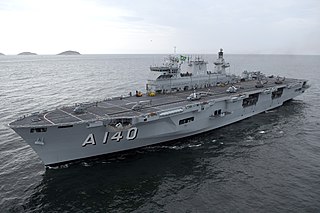
Landing platform helicopter (LPH) is a term used by some navies to denote a type of amphibious warfare ship designed primarily to operate as a launch and recovery platform for helicopters and other VTOL aircraft. As such, they are considered a type of helicopter carrier.

A dock landing ship is an amphibious warfare ship with a well dock to transport and launch landing craft and amphibious vehicles. Some ships with well decks, such as the Soviet Ivan Rogov class, also have bow doors to enable them to deliver vehicles directly onto a beach. Modern dock landing ships also operate helicopters.
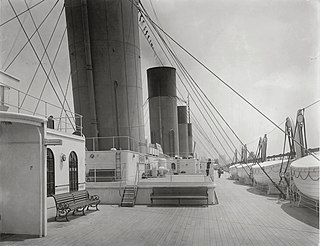
A deck is a permanent covering over a compartment or a hull of a ship. On a boat or ship, the primary or upper deck is the horizontal structure that forms the "roof" of the hull, strengthening it and serving as the primary working surface. Vessels often have more than one level both within the hull and in the superstructure above the primary deck, similar to the floors of a multi-storey building, that are also referred to as decks, as are certain compartments and decks built over specific areas of the superstructure. Decks for some purposes have specific names.
The names of commissioned ships of the United States Navy all start with USS, for United States Ship. Non-commissioned, primarily civilian-crewed vessels of the U.S. Navy under the Military Sealift Command have names that begin with USNS, standing for United States Naval Ship. A letter-based hull classification symbol is used to designate a vessel's type. The names of ships are selected by the Secretary of the Navy. The names are those of states, cities, towns, important persons, important locations, famous battles, fish, and ideals. Usually, different types of ships have names originated from different types of sources.
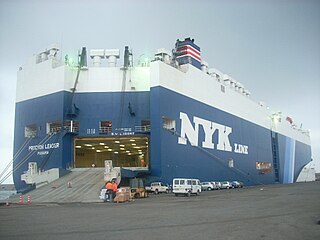
Roll-on/roll-off ships are cargo ships designed to carry wheeled cargo, such as cars, motorcycles, trucks, semi-trailer trucks, buses, trailers, and railroad cars, that are driven on and off the ship on their own wheels or using a platform vehicle, such as a self-propelled modular transporter. This is in contrast to lift-on/lift-off (LoLo) vessels, which use a crane to load and unload cargo.

A Landing Craft Utility (LCU) is a type of boat used by amphibious forces to transport equipment and troops to the shore. They are capable of transporting tracked or wheeled vehicles and troops from amphibious assault ships to beachheads or piers.
A joint support ship (JSS) is a multi-role naval vessel capable of launching and supporting joint amphibious and airlift operations. It can also provide command and control, sealift and seabasing, underway replenishment, disaster relief and logistics capabilities for combined land and sea operations.

The San Giorgio class are amphibious transport docks (LPD) built by Fincantieri for the Italian Navy. These ships can carry a battalion of troops, and up to 36 armored vehicles. The stern floodable dock can accommodate three landing craft. The ships are based at the Brindisi naval base on the Adriatic coast.

An amphibious assault ship is a type of amphibious warfare ship employed to land and support ground forces on enemy territory during an amphibious assault. The design evolved from aircraft carriers converted for use as helicopter carriers. Modern designs support amphibious landing craft, with most designs including a well deck. Like the aircraft carriers they were developed from, some amphibious assault ships also support V/STOL fixed-wing aircraft and have a secondary role as aircraft carriers.
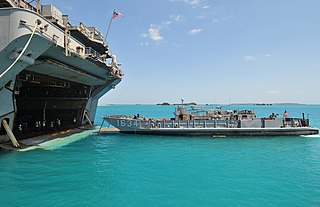
In modern amphibious warfare usage, a well dock or well deck, officially termed a wet well during U.S. Navy instruction when the well deck is flooded for operations, is a hangar-like deck located at the waterline in the stern of some amphibious warfare ships. By taking on water the ship can lower its stern, flooding the well deck and allowing vessels such as boats and landing craft, amphibious vehicles, and recovered spacecraft crew capsules to dock within the ship.

An amphibious warfare ship is an amphibious vehicle warship employed to land and support ground forces, such as marines, on enemy territory during an amphibious assault.

The Ashland-class dock landing ship were the first class of dock landing ship of the United States Navy. They were built during World War II. A dock landing ship is a form of auxiliary warship designed to support amphibious operations. Eight ships were built for the United States Navy and they remained in US service until the 1960s. Two of the class were sold for export overseas, with one joining the Republic of China Navy and the other the Argentinian Navy. The two transferred ships stayed in service until the 1980s. All eight ships were scrapped.
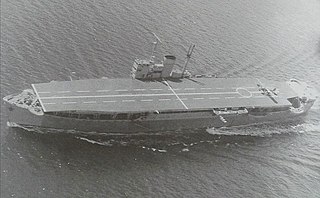
Landing craft carriers or landing craft depot ships were an innovative type of amphibious warfare ship developed by the Imperial Japanese Army during World War II. The prototype was developed in secrecy under the pseudonyms Ryujo Maru and Fuso Maru using features later adopted by other navies for dock landing ships and amphibious transport docks. Additional ships were built after combat experience validated the concept, but most were completed after the Japanese invasions of the early war, and used primarily as troopships during later operations. Today's amphibious assault ships bear a strong similarity to this concept.


















